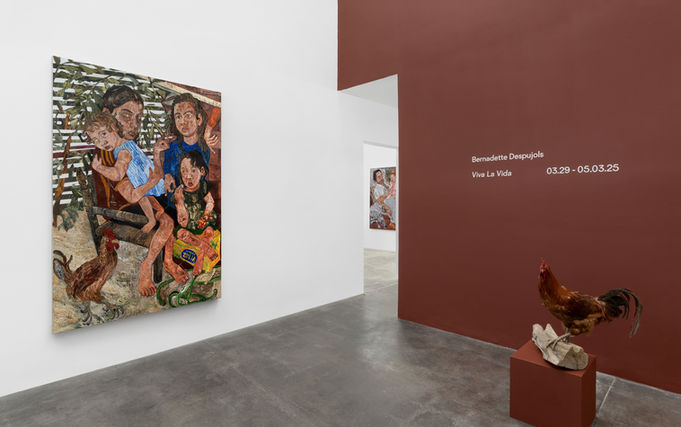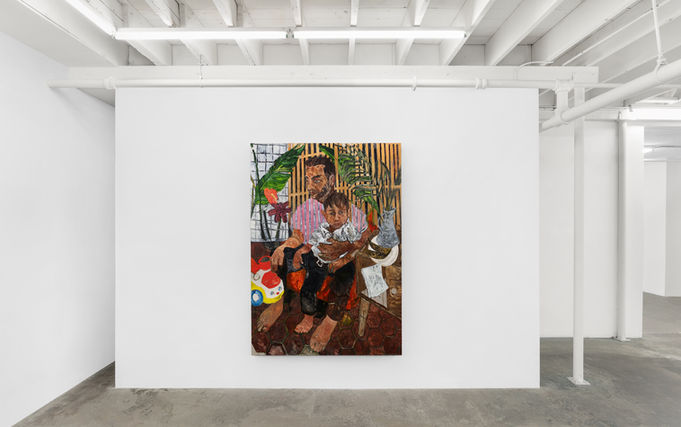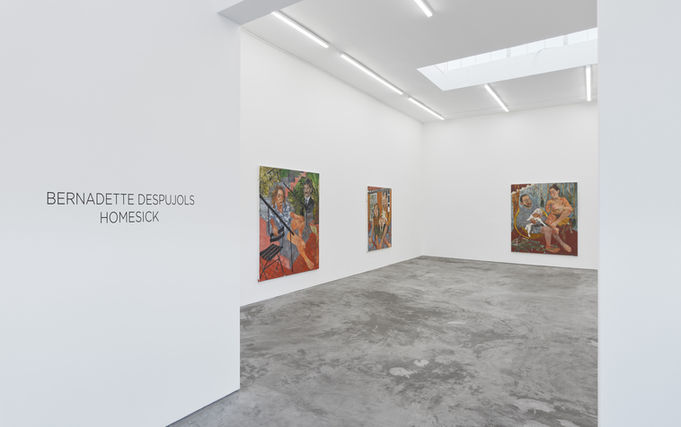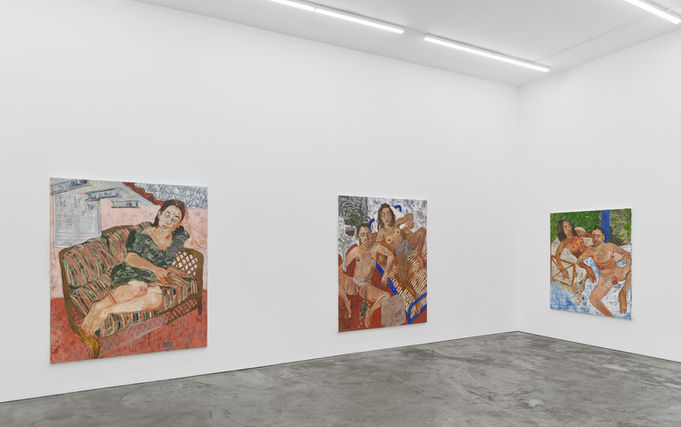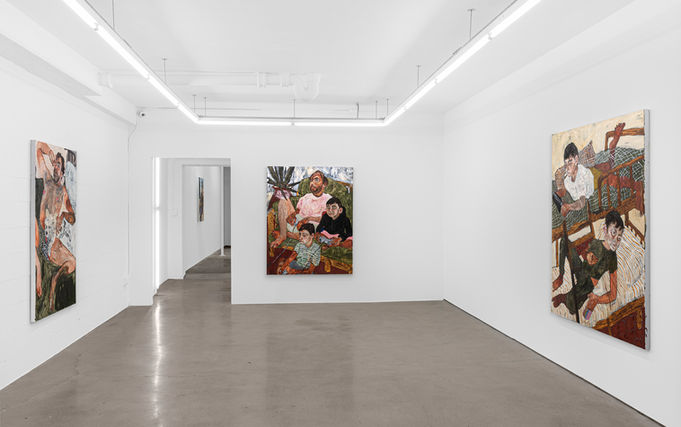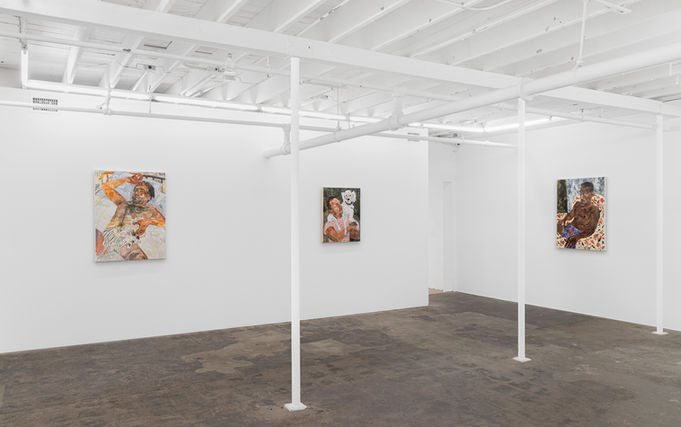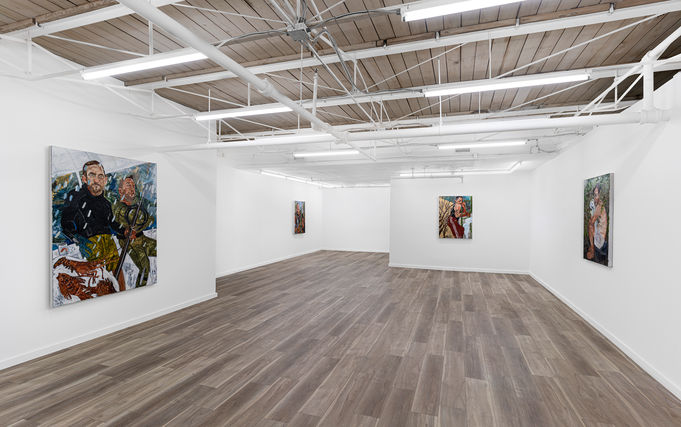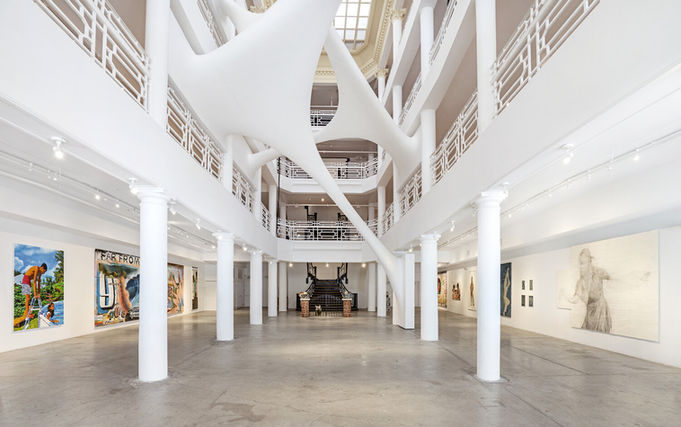Spinello Projects presents Viva La Vida, a solo exhibition by Venezuelan American artist Bernadette Despujols.
Through a deeply personal yet universally resonant body of work, Despujols explores the emotional complexities of migration, diaspora, and resilience, showing a glimpse into her lived experiences and those of countless others displaced by political turmoil. In Viva la Vida, Bernadette Despujols reflects on the complexities of resilience and joy. Her paintings honor both the vibrancy of endurance and the inevitability of transformation. This is the artist's second solo exhibition with the gallery.
Rooted in her journey from Venezuela to the United States, Despujols’ paintings address the tensions of leaving one’s homeland, raising children in a foreign country, and navigating the duality of nostalgia and adaptation. Her work embodies both the fragility and strength of the migrant experience, employing heavy, layered brushstrokes that capture the visceral weight of displacement. The body serves as a central motif in her practice, a vessel of memory and transformation, amplifying the role of women and mothers in the diaspora.
Despujols’ visual language is rich with symbols of her homeland, incorporating portraits of Venezuelan immigrants, family members, and friends alongside flowers native to Venezuela, domestic interiors, and animals such as iguanas and dogs. The iguana, recurring throughout her work, takes on multiple meanings—sometimes invasive, sometimes mythical, echoing the dragon motif in her reimagining of Saint Michael as a woman vanquishing a beast. In her painting "Defeated Dragon or Dead Iguana" which portrays her niece holding an iguana carcass, Despujols captures the unsettling juxtaposition of innocence and violence, underscoring the uneasy coexistence of safety and threat within a displaced identity.
Themes of subversive violence contrast with domestic life in the background, reflecting the political unrest that forced Despujols and so many others to leave Venezuela. Yet, her work resists despair, embracing a bittersweet duality—both happy and sad, familiar yet foreign. The exhibition engages with notions of home and belonging, where even domestic objects like hoses take on serpentine, almost menacing qualities, evoking childhood memories and the unpredictable nature of exile.
Despujols also reflects on the broader crisis of Venezuelan migration, particularly the perilous journeys undertaken by those crossing the Darien Gap. Her work insists on the right to live, the right to seek a better life beyond the dictates of politicians and national causes. The quiet tension between passion and division permeates her practice, confronting intolerance while preserving the humanization of the migrant experience.
In Viva La Vida, Despujols constructs an intimate and poetic space for dialogue, inviting viewers to engage with the emotional labor of migration while celebrating resilience. Through a balance of raw emotion and quiet defiance, her work honors both the past and the possibilities of new futures.
Exquisite Cuerpo
April 26 - June 29, 2024
Opening Reception: Friday, April 26, 6 - 8pm
Rachel Uffner Gallery
Rachel Uffner Gallery is pleased to present Exquisite Cuerpo, Bernadette Despujols’ second solo exhibition at the gallery. An intimate meditation on family, womanhood, and ecological consciousness, the exhibition draws together a body of work that is both visually and thematically interconnected, creating a poignant, immersive narrative throughout the gallery.
“Cuerpo”, the Spanish word for “body”, references Despujols’ portraiture practice, which has long centered on the artist’s close knit matriarchal family and has now taken on an even greater level of intimacy spurred by the recent birth of her daughter Coromoto. In one painting, the artist depicts her newborn playing with a conch shell and guarded lovingly by two lounging puppies. In another, she reflects on her own body and personhood during her pregnancy. The composition pays homage to Miranda en la Carraca by Arturo Michelena, an iconic painting of the Venezuelan revolutionary in his prison cell in Spain. Despujols depicts herself in a similar reclining pose and pensive expression against an impassive, stone wall, simultaneously evoking feelings of tranquility, confinement, and anticipation.
The other figures in the show are all members of Despujols’ extended Venezuelan-American family – nieces, sisters, cousins that all live nearby one another in Miami. Her focus on depicting women immersed in nature is rooted in tenets of ecofeminism, which draws connections between the exploitation of the natural world and the oppression of women. The artist’s tender portrayals of the women in her family, shown against lush foliage and blooming flowers, provocatively explore the ways through which patriarchal society exerts dominance over both women and nature. At the same time, the artist shares how the experience of giving birth made her feel greater respect towards her own body and disrupted preconceptions of the fragility of women’s bodies. In Despujols’ paintings and her reflections on the world around us, the parallels between the natural world and the woman’s body are undeniable —both resilient, formidable, and uniquely capable of bearing life. These inherent bonds between womanhood and the environment shine through in each intimate portrayal of the artist’s family members as they repose in the garden, scramble up trees, and play barefoot among the leaves.
To create her oil paintings, Despujols works from largely candid photographs she informally takes of her family and begins the compositions with faces, conceiving the lines and contours that make up her figures’ emotive expressions before expanding outward to their
limbs, poses, and settings. She constructs each portrait with heavy impasto, building paint up with frenetic brushstrokes then carving lines out to reveal the underpainting beneath. Her unstudied portraiture, combined with sculptural surfaces and vigorous mark-making, evokes the profound human interiority contained within the work of Alice Neel and Lucian Freud.
The show takes its title from Exquisite Corpse, a game invented by the Surrealists in which each participant takes turns drawing on a sheet of paper while seeing only what the previous contributor drew until an elaborate, often absurd, scene unfolds. Just like in the game, which Despujols loved to play as a child, all the paintings in the exhibition are visually connected, creating a fragmented panorama that extends throughout the gallery.
Friends & Lovers
OCTOBER 6, 2023-JANUARY 20, 2024
545 West 25th Street, 9th Floor, New York, NY 10001
Friends & Lovers is an expansive group exhibition that centers on relationships between artists and their subjects and explores the infinite ways, both past and present, we are influenced by our inner circles. Just as a studio visit opens a window into an artist’s creative process, who they choose to immortalize through paint, bronze, photography, etc. similarly provides insight into who serves as their inspiration, be that a lover, partner, family member, friend, celebrity crush, or a fleeting encounter.
Friends & Lovers looks at portraiture through the lens of Alice Neel’s assertion that she painted “pictures of people.” Eschewing portraiture’s bourgeois associations, Neel sought to paint resonant, unheroic images of people in her life that were true to her experience of them, as seen in a bracing 1952 painting of her doe-eyed, young son Hartley. Likewise, works by over fifty contemporary artists encompass a range of tender, unexpected, complex, and personal moments with and connections to their sitters, creating urgent and ultimately timeless pictures of their people. Artists include María Berrío, Peter Cain, Sophie Calle, Srijon Chowdhury, Alex Bradley Cohen, Will Cotton, Patricia Cronin, Anthony Cudahy, John Currin, Bernadette Despujols, Christopher Duffy, Nicole Eisenman, Shanique Emelife, Awol Erizku, Eric Fischl, LaToya Ruby Frazier, Ewan Gibbs, Jerrell Gibbs, Nan Goldin, Felix Gonzalez-Torres, Jenna Gribbon, Emiliana Henriquez, Patty Horing, Doron Langberg, Shona McAndrew, Dave McKenzie, Sam McKinniss, Marilyn Minter, Alice Neel, Arcmanoro Niles, Aliza Nisenbaum, Jennifer Packer, Elizabeth Peyton, Jack Pierson, Alessandro Raho, LJ Roberts, Audrey Rodriguez, Thomas Ruff, Paul Mpagi Sepuya, Mike Silva, Rudolf Stingel, Ruby Sky Stiler, Billy Sullivan, Claire Tabouret, Alessandro Teoldi, Wolfgang Tillmans, Jim Torok, Justin Wadlington, Xiao Wang, Anna Weyant, D’Angelo Lovell Williams, and Sung Jik Yang.
BERNADETTE DESPUJOLS:
OH, MAN!
OCTOBER 8, 2022 - JANUARY 29, 2022
2111 Flora Street, Suite 110
Dallas, TX 75201
The Green Family Art Foundation is pleased to present Oh, Man!, a solo exhibition of works by Venezuelan artist, Bernadette Despujols. The exhibition, presented in the foundation’s Spotlight Gallery, opens on October 8, 2022 and remains on view through January 29, 2023.
A text by Darryl Ratcliff accompanies the exhibition.
Bernadette Despujols Makes Painting Come Alive
What pictures do not fully capture in Bernadette Despujols work is how luscious the surfaces of her canvases are. There is a vitality, like the artist’s hand is the wind and it is rippling the surface of the painting, infusing the work with power and life. It reminds me of the verse Genesis 1:2, “Now the earth was formless and empty, darkness was over the surface of the deep, and the Spirit of God was hovering over the waters.” Despujols hovers over the work, which in turn demands the viewer do the same. Her techniques of scratching, scraping, layering, molding — approaching the canvas with the freeness of a sculptor — makes one lament how often artists choose to pursue a flat pictorial plane.
In her work Ciro, 2022, a man reclines on a white chair, wearing shorts and a t-shirt, holding a yo-yo in his hand, while a garden hose lays in a tangle by his feet. His t-shirt says, “Abortion rights are human rights,” and his melancholy gaze is looking away from the viewer. These men that Despujols is painting do seem tired, forlorn, and resolute. They are all reclining or sitting — and by the caked-up paint on their faces one can infer that they are in need of rest.
In Rafael y Sigfredo, 2022, one figure sits on a wicker stool in a pink, short sleeve shirt and shorts, while the other figure wears pants and a gray sweater that says, “Her body, her right, her choice.” Once again, these figures are not looking at each other or the viewer; it is as if they are captured deep in thought after some great debate. The cigarettes and cups of coffee on the table are remnants of their social life. There is a juxtaposition of the messaging of the t-shirts and how these men are painted which make them the most unlikely of activists. It’s a world where male support of gender equality is as mundane and uneventful as playing with a yo-yo, drinking coffee, and smoking cigarettes.
There are many tropes that unite this body of work. Despujols often uses a checkered, grid-like tile floor that is then echoed in the pattern of a shirt or a chair. Typically, there is also the use of lush foliage that can make it difficult to know if the subject is inside or outside. Her subjects are engaged in leisurely domestic activities; They are with their children, their dogs, and their birds. Despujols also clearly loves and is quite skilled at using the color white.
Although there are larger themes of intimacy and women’s rights throughout the works, the small moments are breathtaking. The way Despujols can work the wicker of a bench to have a slight give from the weight of the figure sitting in it. The simple scratch mark delineates the string of a yo-yo in one painting, and then the detailed braiding almost rosary like treatment of the string of the yo-yo in the next. Despujols is constantly working and reworking these concepts. It is not just that there are tile floors — it is that there are five different ways to make tile floors interesting. Now let me show you what I can do with foliage, with the foot of a sofa, let’s have eight different flesh tones make up a leg. It’s heady, dizzying, and delightful stuff from an artist who is clearly in love with the process of painting. Nothing is mailed in; if there is an opportunity to add a bit more soul or flourish — the artist takes it. That the paintings can be so ferocious and yet, intimate, and quiet is a singular achievement.
About the Green Family Art Foundation:
The Green Family Art Foundation is a non-profit 501(c)(3) organization.
The foundation’s mission is to provide a venue for, make grants to museums for the benefit of, and educate others about contemporary artists we believe communicate important ideas that are relevant and discussion worthy today and in the future.
The exhibition is located at 2111 Flora Street, Suite 110, Dallas, TX 75201. Hours are Wednesday-Friday, 11am-5pm and Saturday-Sunday, 11am-6pm. Admission is free.
For press inquiries, please reach out to info@greenfamilyartfoundation.org or call 214-274-5656.
Nino Mier Gallery is pleased to present Homesick, an exhibition of new paintings by Venezuelan artist Bernadette Despujols. Despujols, who is now based in Miami, Florida and Brooklyn, New York, created this body of work as a meditation on her home country and her friends who, like the artist, immigrated from Venezuela to the United States. New paintings exploring memory, nostalgia, identity, and belonging, will be on view from September 16 – October 15, 2022 in Los Angeles.
Homesick features a series of portraits of the artist’s friends and family, all of whom have migrated from their home country to the United States. Despujols painted her subjects as they sat for her in her studio, but recontextualized them within domestic scenes typical of their hometowns in the paintings. After either receiving photographs of or researching the interiors and exteriors of houses typical of her friends’ hometowns, Despujols re-immersed her subjects within the spaces they are homesick for.
Mementos of the subjects’ histories crop up in each painting, from the CLAP box — a government-subsidized food distribution program — in Caja Clap, to the bust of Jose Hernandez – a Venezuelan saint and doctor—in Gala en La Comarca. Floor drains appear throughout the exhibition, as they are built into most rooms in Venezuelan homes to allow for easier cleaning and drainage, a feature absent in most houses in the States. The inclusion of such details reminds us of how the small conveniences, inconveniences, or quirks in our daily lives can be charged with nostalgia and longing once they recede into the past.
A sense of the haptic and palpable permeates the works, counterposing the subjects’ interest in intangible memories. After using thick gesso to create the compositions’ backgrounds, Despujols applies layers of paint with varying degrees of thickness and texture. She scrapes the canvas with knives and creates fine incisions to match the illusionistic space of the compositions with a surface depth that is equally complex. Skin often comes to resemble the wood of the surrounding interiors—a formal blending of person and environment that unites the subjects with their histories.
WE ARE FAMILY
February 1 – March 6, 2022
New York Academy of Art
111 Franklin Street, NYC 10013
212 966-0300
Spinello Projects presents I Love You, Man, the debut solo gallery exhibition by Venezuelan artist Bernadette Despujols. The exhibition features a suite of oil paintings depicting men who are close to the artist, on view at the Gesamkunstwerk Building at 2930 NW 7th Avenue.
In I Love You, Man Bernadette Despujols paints the closest men in her circle. The paintings are a departure from her usual depictions of women in paintings. In previous paintings of fully nude women, Despujols positioned herself as the subject of her paintings although they were portraits of anonymous unconscious women sourced from pornography made by men. Holding the belief that to be a woman makes other people uncomfortable and ultimately poses a threat to men she turns her gaze and paints the cishet men in her life: friends, lovers, family. Despujols uses the portraiture of her male subjects to experience her relationships with deeper intimacy. Objectification and intersubjectivity (the relation or intersection between people's cognitive perspectives) ebbs and flows between the painter and the painted. She objectifies the men in the paintings at times, focusing solely on one body part or their bare skin and bodies, but the men pose for the pictures with awareness and dignity. Nothing is stolen from them; Despujols may want to position these men ironically as muses but the truth is she defeats the irony of it with pure affinity and care towards the people she paints, leaving the men to decide what they want to wear and show of themselves. In the act of portraiture she experiences the vulnerability of these men through their quiet shyness or awkwardness with themselves, ways that would otherwise challenge the presumed status quo of manhood: tough, aggressive, aloof, qualities of patriarchy that, to Despujols, imprison both men and women in a cycle of violence. The paintings are formally infused with skewed perspectives, foreground and background foibles, and blank, paintless spaces furthering the playfulness she captures by being around the men she loves.
Curated by Melahn Frierson and AJ Girard
Moore Building | Miami Design District
Shattered Glass, the acclaimed exhibition of new art by emerging artists of color that was shown at Jeffrey Deitch Los Angeles last spring, will be presented in an expanded version in the Moore Building in the Miami Design District from November 29 – December 5, 2021. The exhibition will be Deitch’s sixth and final project in the Moore Building atrium space before the iconic site comes under the stewardship of WoodHouse, the concept creation collaborative. The exhibition is presented in partnership with the Miami Design District, WoodHouse and GOAT.
The Los Angeles version of Shattered Glass, curated by Melahn Frierson and A.J. Girard, was more than an exhibition, it was a phenomenon, attracting 1,000 visitors per day in its final weeks. Shattered Glass connected with a diverse art audience, giving visitors a rare opportunity to see art that reflected their own life experience. Frierson and Girard selected emerging artists from Los Angeles, Miami, Baltimore, Dallas, New Jersey and less likely cities like Fresno. Many of the artists knew each other prior to the exhibition. The show represented communities in addition to individual talents. The expanded Miami version of Shattered Glass will include fifteen new artists.
The painting, sculpture and photographic works in the exhibition are all figurative. The subject matter is often the artists’ family and friends. Their primary subject is their own life and their community. Many of the works also display extraordinary technical skill and mastery of traditional painting techniques. A number of the artists also apply industrial techniques such as air brush and use unexpected materials like adobe, glitter and synthetic hair.
The participating artists are strongly socially engaged. Several of the artists donate part of their sale proceeds to the people portrayed in their works. Many of the works have a powerful social message. There is also an emphasis on the strength of family and community ties. In a story on the exhibition in The New York Times, Robin Pogrebin wrote: “There is a joyfulness in the work, one that attests to the resilience of the artists and the people they depict.”
With a few exceptions, all of the artists are in their ‘20s and early ‘30s. The exhibition represents a remarkable new generation that connects with a new art audience
Bernadette Despujols:
The Vast Ocean in Which the Woman Swims
curated by Ché Morales
September 7 - October 3, 2021
Rachel Uffner Gallery is pleased to present The Vast Ocean in Which the Woman Swims, the gallery’s first solo exhibition with Bernadette Despujols, curated by Ché Morales. This body of work features Despujos’s recent series of paintings and sculptures that confront the objectified view of the female body as informed by her own perspective and experiences. Despujols explores themes that go beyond the expected identity of a woman drawing inspiration from the many dynamic women that have played important and personal roles in her life including her Mother, Grandmothers, sisters, nieces, cousins, friends, and even colleagues that have shaped who she has become.
Despujols takes a seemingly sculptural approach to painting as she vigorously fills her canvases with thick and energetic brushstrokes, that at times are also retracted and scraped away to resurface the underpainting. These textural portraits invoke emotional and profound imagery reminiscent of artists such as Alice Neel or Jenny Saville.
With these paintings, she portrays various women in all possible scenarios and stages of their lives such as: A collection of portraits of women as young girls, mothers, children, elderly, healthy and sick. Despujols states, “I want to explore the vast ocean in which the woman swims, (one that I am yet to fully understand) one that goes way beyond those absurd expectations of what women should be.”
At first glance, some might find it strange to place a “sexualized” sculpture next to the painting of a child or a mother with her children, or an older woman. However, Despujols wants to remind the viewer that the “sexualized” woman was once a little girl that would eventually become an older woman. That a woman is not just one of a certain age, women are of many ages and many faces. She wants to remind everyone that the patriarchy wants to separate women into specific, uniquely stereotyped stages.
For example, Despujols represents how the perception of ideal femininity is ingrained from an early age with the painting of Cassandra and Gala. Here, one figure wears a Smurfette t-shirt referencing the artist’s own childhood memory of watching the cartoon aptly titled, “Los Pitufos” or “The Smurfs". She would always wonder how despite the many male characters with their countless personalities be it sleepy, grumpy, surprising, old, or funny, there was only one “girl,” and she was simply characterized as “pretty”. Despujols transforms this formative memory into one of many visual examples to emphasize the dismissal of the female identity.
Many of her paintings in this show are based off of photographs —some she has taken herself, she has found second hand or were sent to her by friends and family. Despujols finds the process of painting these images as a sort of translation, from one language to another. In this translation, many details may go missing, change or mutate. The image that she produces does not attempt to look photorealistic, or realistic in any way. It is its own version of reality, existing in a realm in which fact and fiction do not exist. A story with a reality that now solely exists on the canvas.
A selection of sculptures in the center of the room completes the exhibition. These sculptures are from Despujols' Inflatable Love Dolls series and are comprised of five female busts fabricated from soft latex sex dolls filled with concrete. The inflatable love doll she uses is a representation of the female body; it is both figurative and abstract, as it tries to reproduce the female figure, yet remaining true to its origins as an inflatable structure. Through her practice, Despujols reclaims these agent-less inflatable objects into something completely new. As the concrete begins to set, the weight responds to gravity and transforms the shape of the once static doll into a more substantial human form. Though it is evident that their extremities and heads are missing, the sexual orifices still remain, highlighted, in their original yet impenetrable pink plastic.
Through their transformation, these torsos have now become symbols of an impossible objectification or abuse.They are no longer possible to penetrate, and their pleasure-inducing cavities have been filled. Instead of soft objects with the sole purpose of fulfilling the desire of men in their solitude, they now stand firm like a truncated contemporary version of Hellenistic torsos. Despujols references the Greek goddess Aphrodite as an example of this mythological presence. Aphrodite also embodied themes of love, beauty, pleasure, passion, and procreation. Despujols hopes that the viewer will find these same themes and complexity of character within the portraits surrounding gallery walls.
Bernadette Despujols (b. 1986, Barquisimeto, Venezuela) studied Architecture at the Universidad Central de Venezuela (UCV), where she graduated with honors in 2007. Soon after, she continued her education at the École Nationale Supérieure des Beaux-Arts in Paris, where took classes in architecture, cultural exchange, morphology and anatomy before beginning her endeavors in art making. Despujols taught Architectonic Design at the School of Architecture at the Universidad Central de Venezuela before moving to the US to pursue her MFA in Visual Arts at the California Institute of the Arts (Cal Arts) in 2010. Despujols’ artistic practice is highly expansive, as she incorporates a wide range of different media, including painting, sculpture, video and installation. Her current work revolves and questions historical allusions, myths and references regarding the perception of women, sex and contemporary life. She shares her time between her architectonic firm and her art practice. Despujols lives and works in Miami since 2013.
CURRENTS: An Overwhelming Response
Curated by Carmen Hermo
Mimi Bai, Sera Boeno, Nikesha Breeze, Becky Brown, Caryl Burtner, Bernadette Despujols, Priscilla Dobler, Debora Hirsch, Elektra KB, Nsenga Knight, Le’Andra LeSeur, Nikki Luna, Stefana McClure, Rosemary Meza- DesPlas, Nelson Morales, Pamela Rush, Alicia Smith, Caroline Wayne, Connie Zheng
January 10 – February 9, 2020
A.I.R. Gallery is proud to present the 6th edition of CURRENTS, an open call exhibition series in which artists respond to current topics, with this iteration addressing the theme of gaslighting and manipulation.
The 19 international artists in this exhibition, CURRENTS: An Overwhelming Response, represent a plurality of voices exploring and pushing back against experiences and ramifications of gaslighting—or manipulations of reality—on individuals, communities, and culture. The title is drawn from Le’Andra LeSeur’s video work, An Overwhelming Response, which tracks the dismissals, denials, and violent backlash to Black women reporting sexual assaults. This title also evokes the artistic responses to the show’s open call, and the exhibition includes a diverse range of media encompassing sculpture, video, photography, painting, textile, and works on paper. Many of these artworks model healing and shifts in perception to bolster self-knowledge and solicit community support in the face of trauma.
Gaslighting undermines, isolates, and divides. The term comes from the 1938 play and 1944 film Gaslight where a woman
is manipulated by her husband to paranoid extremes of self-doubt and anxiety, though she is ultimately vindicated. In the exhibition, Stefana McClure’s accumulative graphite transfer drawing of the film’s subtitles creates a visual field of that emotional turmoil. In vivid color, Becky Brown’s watercolors explore emotional ranges of numbness and revolt, judgment and concern.
In today’s global culture of nationalism and neo-fascism intertwined with misogyny, “fake news” and “straight talk” by men in power foster violence and abuse. Nikki Luna’s bathroom mirror activation and marble sculpture quote Rodrigo Duterte, President of the Philippines, in his crass, sexist public comments on rape and women’s bodies. Caryl Burtner takes a scissor to American politics, using anagrams to reveal the duplicity behind members of the current administration. Connie Zheng’s two-channel video narrates U.S. media’s manipulation of perceptions of China and its environmental conditions, especially in the artist’s hometown of Luoyang. Nsenga Knight’s video documentation of a performance restaging speeches by Malcolm X with contemporary African-American Muslims, reveals that the meaning and intentions behind X’s speeches were grossly misstated by U.S. media and leadership. Bernadette Despujols’s disturbing paintings bring wider attention to the violence of Venezuela’s current crisis, where non-governmental media is censored and reality obscured.
Many of the artists in this exhibition explore gaslighting’s impact on relationships with others as well as understand of ourselves. Sera Boeno’s delicate bronze adornments refer to Ottoman-era edicts declaring women as the “ornament of her house,” visualizing women’s silence over the centuries. Debora Hirsch created a mirror in which one’s reflection is gradually overtaken with insistent, insidious verbal and emotional abuse, showing commonplace and life-ending violence in a continuum. Caroline Wayne’s intimate, bedazzled object illustrate dream scenes produced by childhood abuse and trauma bonding. Elektra KB constructs a Survivor Medicine Cabinet out of remnants of an abusive relationship, pairing it with a textile letter alluding to abuse in queer communities. Pamela Rush’s video performance reenacts the words of misogynist, self-hating women in mass media, and LeSeur’s An Overwhelming Response shows the violent skepticism of mass media and internet commentators. Rosemary Meza-DesPlas uses the greyed hair of a lifetime of experience to embroider an image of rage in What You Whispered, Should Be Screamed, and that same sense of power and loss is abstracted in Mimi Bai’s sculptural Ghost.
Importantly, select artists in the exhibition establish new pathways for communication, self-knowledge, and healing through care and by prioritizing empathy and lived experience over traditional notions of expertise. Nikesha Breeze’s Ritual: Visceral: Memory uses ablution, touch, and the recitation of healing text to reclaim bodily knowledge and power. Nelson Morales’s photograph MUXE is a portrait of an elder member of the artist’s muxe community in Oaxaca, Mexico, where this third gender is valued and celebrated. Alicia Smith’s two video projections insist on the realities of trauma with repeated calls of “I Believe You” and by honoring indigenous Xicano women. Priscilla Dobler uses indigenous weaving traditions and sound to herald a rebirth of society through storytelling.
The work on view in CURRENTS: An Overwhelming Response represents the final selection from an overwhelming response
to the open call itself, attesting the importance of naming and visualizing all forms of gaslighting and abuse in 2020. By presenting this array of works, A.I.R. Gallery continues to build on expanded conversations about feminism in art, allowing for the works of these powerful women and gender non-conforming artists to foster connection and communication.
LVL3 presents, Circle Within a Square, a two-person exhibition featuring Bernadette Despujols and Brittney Leeanne Williams. Despujols’ violent, painterly style confronts contemporary mythologies of women while Williams’ transcendent use of deep red nods to generational and embodied feminine roles.
Williams’ paintings feature black women prominently in the composition, blending foreground and background, landscape and subject. The bodies are bent: their postures suggest a state of rest, a burden carried, lovemaking, being anchored. Williams uses these figures and their positionality to reference her own relationship to family history while at the same time speaking about chronicled female characters such as Naomi and Ruth from the Book of Ruth.
Despujol’s sculptures and paintings speak about the female body in today’s cultural and social contexts, questioning and embracing notions of objectification and intimacy. Despujol’s compositions depict naked sitting female-bodied figures in their home, on a bed or sitting on a man’s lap; forcing a viewer to question whether the scene depicted is intrusive or empowering. Similarly lonely and internal, Despujol’s interruptions of objects and furniture designed for the body are transfigured to become the body in question.
Bending, sitting, propped on chairs or inside a vast landscape, Despujols and Williams’ figures disrupt space through their dynamic expressions of womanhood.
